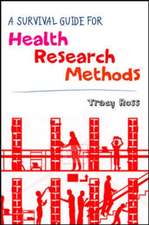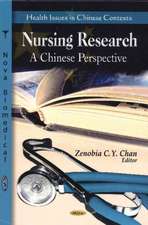Principles of Translational Science in Medicine: From Bench to Bedside
Editat de Martin Wehlingen Limba Engleză Hardback – 22 iul 2021
New chapters include: Translation in Oncology, Biologicals, and Orphan Drugs. The book is ideal for use as a guide for biomedical scientists to establish a systematic approach to translational medicine and is written by worldwide experts in their respective fields.
- Includes state-of-the-art principles, tools such as biomarkers and early clinical trials, algorithms of translational science in medicine
- Provides in-depth description of special translational aspects in the currently most successful areas of clinical translation, namely oncology and immunology
- Covers status of institutionalization of translational medicine, networking structures and outcomes at the level of marketing authorization
| Toate formatele și edițiile | Preț | Express |
|---|---|---|
| Hardback (2) | 569.99 lei 5-7 săpt. | |
| ELSEVIER SCIENCE – 9 apr 2015 | 569.99 lei 5-7 săpt. | |
| ELSEVIER SCIENCE – 22 iul 2021 | 750.39 lei 5-7 săpt. |
Preț: 750.39 lei
Preț vechi: 952.43 lei
-21% Nou
Puncte Express: 1126
Preț estimativ în valută:
143.59€ • 153.54$ • 119.72£
143.59€ • 153.54$ • 119.72£
Carte tipărită la comandă
Livrare economică 11-25 aprilie
Preluare comenzi: 021 569.72.76
Specificații
ISBN-13: 9780128204931
ISBN-10: 0128204931
Pagini: 494
Ilustrații: 105 illustrations (40 in full color)
Dimensiuni: 216 x 276 mm
Greutate: 1.68 kg
Ediția:3
Editura: ELSEVIER SCIENCE
ISBN-10: 0128204931
Pagini: 494
Ilustrații: 105 illustrations (40 in full color)
Dimensiuni: 216 x 276 mm
Greutate: 1.68 kg
Ediția:3
Editura: ELSEVIER SCIENCE
Public țintă
All biomedical researchers from preclinical to clinical scientists need to understand and apply translational science in medicine, which applies to scientists in pharmaceutical industry though almost all principles are applicable to device development. Additionally, academic researchers will need the book, as well.Most major universities offer courses, programs (e.g. master programs) in translational medicine for which the book is ideal as the basic teaching material. It is currently used in courses on pharmaceutical medicine e.g. at Basle University.
Cuprins
Part I: Introduction
1. Introduction and definitions
2. Problems, challenges, and initiatives in translation
Part II. Target identification and validation
3. “Omics translation: a challenge for laboratory medicine
4. The power of genomics, metabolomics, and other omics for target identification and validation
5. Potency analysis of cellular therapies: the role of molecular assays
6. Translational pharmacogenetics: pharmacogenetically driven clinical decision making
7. Tissue biobanks
8. Animal models: value and translational potency
9. Biomarkers in the context of health authorities and consortia
10. Human studies as a source of target information
11. Target profiling in terms of translatability and early translation planning
Part III. Biomarkers as key elements of successful translation
12. Biomarkers
13. Genetics, molecular biomarkers, and artificial intelligence to improve diagnostic and prognostic efficacy
14. Cardiovascular translational biomarkers: translational aspects of hypertension, atherosclerosis, and heart failure in drug development in the digital era
15. Biomarkers in oncology
16. Translational medicine in psychiatry: challenges and imaging biomarkers
Part IV: Early clinical trial design
17. Methodological studies
18. The pharmaceutical research and development productivity crisis: can exploratory clinical studies be of any help?
19. Adaptive trial design
20. Combining regulatory and exploratory trials
21. Accelerating proof of concept by smart early clinical trials
Part V: Toxicology in translation
22. Pharmaceutical toxicology
23. Translational safety medicine
Part VI: Special topics in translation
24. Cancer vaccines: translational strategies
25. Translational aspects of biologicals: monoclonal antibodies and antibody-drug conjugates as examples
26. Orphan drugs: why is translation so successful?
Part VII: Biostatistics and modelling
27. Translational science biostatistics
28. Computational biology and model-based approaches in translational medicine
Part VIII. Legal aspects and special interest groups
29. Intellectual property and innovation in translational medicine
30. Translational research in the fastest-growing population: older adults
Part IX. Integration and application of translational guidance
31. Translational medicine: the changing role of big pharma
32. Translational science in medicine: putting the pieces together-biomarkers, early human trials, networking, and translatability assessment
33. Learning by experience
1. Introduction and definitions
2. Problems, challenges, and initiatives in translation
Part II. Target identification and validation
3. “Omics translation: a challenge for laboratory medicine
4. The power of genomics, metabolomics, and other omics for target identification and validation
5. Potency analysis of cellular therapies: the role of molecular assays
6. Translational pharmacogenetics: pharmacogenetically driven clinical decision making
7. Tissue biobanks
8. Animal models: value and translational potency
9. Biomarkers in the context of health authorities and consortia
10. Human studies as a source of target information
11. Target profiling in terms of translatability and early translation planning
Part III. Biomarkers as key elements of successful translation
12. Biomarkers
13. Genetics, molecular biomarkers, and artificial intelligence to improve diagnostic and prognostic efficacy
14. Cardiovascular translational biomarkers: translational aspects of hypertension, atherosclerosis, and heart failure in drug development in the digital era
15. Biomarkers in oncology
16. Translational medicine in psychiatry: challenges and imaging biomarkers
Part IV: Early clinical trial design
17. Methodological studies
18. The pharmaceutical research and development productivity crisis: can exploratory clinical studies be of any help?
19. Adaptive trial design
20. Combining regulatory and exploratory trials
21. Accelerating proof of concept by smart early clinical trials
Part V: Toxicology in translation
22. Pharmaceutical toxicology
23. Translational safety medicine
Part VI: Special topics in translation
24. Cancer vaccines: translational strategies
25. Translational aspects of biologicals: monoclonal antibodies and antibody-drug conjugates as examples
26. Orphan drugs: why is translation so successful?
Part VII: Biostatistics and modelling
27. Translational science biostatistics
28. Computational biology and model-based approaches in translational medicine
Part VIII. Legal aspects and special interest groups
29. Intellectual property and innovation in translational medicine
30. Translational research in the fastest-growing population: older adults
Part IX. Integration and application of translational guidance
31. Translational medicine: the changing role of big pharma
32. Translational science in medicine: putting the pieces together-biomarkers, early human trials, networking, and translatability assessment
33. Learning by experience
Recenzii
"This is an easy to read resource for biomedical scientists interested in the current and evolving approach to integrating various scientific approaches to answer questions important for the diagnosis and treatment of human disease. Score: 86 - 3 Stars" --Doody's








